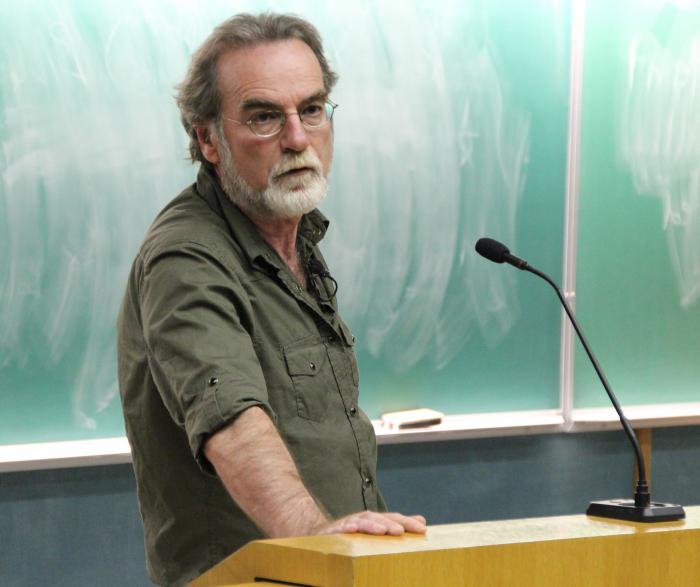Functional-semantic type of speech: description, narration, reasoning
Depending on the content of what we say, philologists divide our speech into three types of functional-semantic speech: reasoning, description, narration. Each of them has its own distinctive features.
In our outer speech shell, in its unique structure, much depends precisely on the task that we set for ourselves in the presentation of thoughts. It is one thing to talk about something, it is quite another to describe some object or area, and the third is to interpret, explain something. Of course, in each of the above cases, the system will constantly change. For far from the first century, scientists have been trying to develop the great and powerful language of Mother Russia. Over all these centuries, the most expressive methods, schemes for certain literary tasks, as well as various verbal structures, have been developed.
Actually, because of this, such functional and semantic types of speech stand out “from the crowd”: description, narration, reasoning. In the field of linguistics they are called functional-semantic types of Russian speech.
Linguists explain the selection of only three types by the fact that all studies were carried out purely for literary and artistic speech. In the event that we have in mind absolutely all diverse texts, the list of such functional and semantic types can increase significantly. So did V. V. Odintsov, who added to the narrative, reasoning, description also a definition (in other words, an explanation). It is difficult to call his actions somehow wrong or something like that, because he is, in fact, right. But now we will not talk about Odintsov, but about functional and semantic types of speech.
Description
A description in linguistics is a functional-semantic type of speech that describes any image, action, object or appearance of the hero (face, eyes, etc.). Take, for example, the case when we describe a portrait. Our attention focuses on the following features: posture and gait, height, eye and hair color, age, clothes, smile, and so on. When describing a room, we indicate its size, appearance, wall decoration, furniture features, number of doors and windows, and much more. If we describe the landscape, the main features will be trees, grass, rivers, sky, lakes, and so on. The common and main thing for all types of description, which will be discussed in more detail a little later, is the simultaneity of all signs. It is important to know that the role of description, as a functional and semantic type of speech, is that a person reading a particular work can imagine the subject described in the text.
As you know, the description is used in all speech styles of the Russian language, but not everything is so simple. In the scientific style, the description of the subject should be extremely complete and specific, but in the artistic text, the emphasis is on the brightest details. It is because of this that the language means of artistic and scientific styles are very different. In a literary text, one can find not only nouns and adjectives, but also adverbs, verbs, common comparisons and words used in a figurative sense.
reasoning
Reasoning, as a functional-semantic type of speech, is a verbal explanation or presentation that confirms or refutes a certain thought (guess).
The composition of this type of functional-semantic speech, like reasoning, is very simple. In the first part of the text there is some kind of thesis - a certain thought, by the end of the text that needs to be proved or refuted. In the second part of such a text, the author must substantiate the idea expressed in the first part, give arguments and evidence, supported by some examples. In the last (third) part of the text, the author draws a conclusion and completes his thought.

The thesis of this type of text must be clearly proven (so that no questions arise), clearly formulated, and the arguments and evidence are convincing in order to refute or prove the thesis put forward earlier. The thesis and its arguments are connected both logically and grammatically. For the correct grammatical connection between the proof (arguments) and the main thesis, most often the authors use introductory words: finally, therefore, firstly, secondly, thirdly, thus and others. In the reasoning text, sentences containing the following conjunctions are often used: despite the fact that, although, however, as well as others.
Narration
Narration is a functional and semantic type of speech, a story or message about an event with all temporal sequences. The narrative has its own peculiarity, which lies in the fact that each subsequent event follows from the previous one. All narrative texts (stories) are united by a common scheme: the beginning of a certain event (in other words, the beginning of the story), the development of the plot, the ending (denouement). The uniqueness of the narrative is that it can be conducted both in the first and in the third person.

Most often in narrative texts, the author uses a variety of perfective verbs in the past tense. However, in order to give the text expressiveness, others are used along with those verbs. The imperfective verb also in the past tense allows the author to highlight one specific action, while denoting its exact duration. Verbs in the present tense make it possible to present all the actions of the story in the form that everything is happening in reality (right in front of the reader). Forms of verbs with the particle "how" give the text a special surprise of a certain moment. Narration, as a functional and semantic type of speech, is most often used in such genres as letters and memoirs.
Description examples
To fully understand what a description is, to learn how to recognize it in the text, we need examples that we will now give. Example number 1 (description of the estate):
“Kochanovskaya estate is located on the river, opposite a small village. The estate is not rich at all, rather, even poor - the building is covered with wood chips, the gate connects the house with several outbuildings. The kitchen is on the left; barn, barn and barn - on the right. The largest window overlooks the river, but the river is not visible. Beautiful trees and bushes grow near the house…”
It is worth noting that the description may also include a sequence of so-called elliptical and nominative constructions. This creates the nominative style of presenting the text, which has become so popular lately, in which various scenes from cinema, dramatic works and entries similar to a diary are most clearly presented. An example is the following text:
“A huge room, a corner of a building; our heroine lived here for more than ten years, and now she spends most of her day in this place. A rather large table for work, in front of it is a light armchair with an incredibly hard seat. A very large closet, a bright map and some other portrait are on the left side of the room ... "
Types of description
As mentioned above, the description is used in a detailed story about a phenomenon, a portrait, if necessary, give a certain characteristic in order to show a holistic image of a particular hero. As you already know, functional-semantic types of speech (description, reasoning and narration) are an integral part of the Russian language, and now more about types of speech types of description.
In all texts of this type, the authors almost always present readers with static pictures that are taking shape in our head in small pieces. The author always lists the objects, some of their features, a detailed description, due to which we imagine this or that situation (picture, landscape, etc.) in our head while reading. If you think a little, you can understand that in each next sentence of the text, some features of what was discussed in the previous one are clarified - this, by the way, is the main feature of the descriptive text. When writing them, you must strictly adhere to the following structure:
- Introduction (first impression).
- Description of all the details around.
- Conclusion (assessment of events, final conclusion).

For several years now, there have been several specific types of descriptive text:
- description of the surrounding nature;
- environment;
- a description that characterizes the personality of a particular person;
- portrait description.
This type is used in various areas of our life, and its parameters depend on the point of view of the author or the narrator, the style of writing, the genre of the text, and much more.
Reasoning example
Reasoning, as a functional and semantic type of speech in the Russian language, plays an important role in such a popular communicative and cognitive process. The type of speech that is now being discussed is a pure deduction of the latest knowledge, and also simply demonstrates both the author's train of thought and the way to solve the problem that has arisen. If you pay attention to the structure of such texts, you can understand that the story is a kind of chain of sequentially interconnected sentences. Example:
“Under the influence of various electromagnetic waves, an atom can go into a reduced energy state or vice versa, and the probability of one or the other outcome is equal. In the second case, the magnetic waves themselves will begin to weaken, and in the first situation, they will increase. In the case when the so-called paramagnet is in warm equilibrium, atomic particles slowly begin to be distributed over certain sublevels. This happens in accordance with the world-famous Boltzmann law. From all of the above, it follows that the number of atomic units that are there in less energy, simply greatly exceeds the number of those atoms that have more energy.

Storytelling Example
Narrative texts reveal certain events that are related to each other. Sentences in narrative texts tell about a particular action, phenomenon, event, etc., but do not describe what is happening in any way. For example:
“In the Moscow region, a special interdepartmental operation called “Help a Child” was launched not so long ago. According to the plans made, it can be understood that the creators (organizers) want to help children who cannot obtain a certificate or passport of a citizen of the Russian Federation. In addition, specialists from the regions of the entire state with great pleasure agreed to help the parents of the children obtain the necessary documents ... "
In short, a narrative is considered a specific story about something - it is a kind of news presented in a magazine or book.
It is important to note that the narrative is considered the main (main) part of the entire text. Many philosophers argue that narration in literature plays the most important role, narration is the soul of all Russian literature. A writer is only a person who is able to present the material to the reader in an exciting and interesting way, and with the help of the narrative mood, this can be done much better.
In narrative texts, the date of what is happening is always accurately indicated, and sometimes also the time, which makes reading such texts much more interesting, because it seems that everything happened exactly as it is told in the book.
Trinity

Taking absolutely any work, and then scrolling through several dozen pages, you will find only three currently known types of Russian speech. This is especially true for novels. No one can write such a work without such functional and semantic types of speech as narration, reasoning and, of course, description. One way or another, in one of its forms, each type occurs in any text. However, some authors try to write a work using only one functional-semantic type of speech, which, of course, they still sometimes succeed, but it is simply impossible to read the text in this spirit. Even if you think about it, who wants to read 200 pages of a story that makes no sense, but it is about some building. The author describes one building on 200 pages - it's terribly boring. Few will want to read this, because most readers love dynamic stories with elements of character description, with certain suspicions, guesses that are revealed only at the end of the work.
The works, based only on the description, can easily be called "booklets" that are given out on every corner of your town. It is simply impossible to build an interesting and intriguing text on the description of something, and if something works out, then it is unlikely that anyone will like it. Therefore, functional-semantic types of speech are distinguished in the Russian literary language. Which ones, we examined in the article.
Functional-semantic types of speech - description, narration, reasoning - are used by authors when writing works. Some creators consider the description the most “inconvenient”, because it is impossible to create a masterpiece using only it. But, for example, you can write an interesting text about something in the style of narration or reasoning, and it is likely that many will like it. Functional-semantic types of speech are distinguished according to certain criteria, which were discussed in the article.
If you still want to read a work in a certain style, no one can forbid you to do this, but it’s better not to waste time on this, but to find a text in which the author used all three types of speech, you will really like this work.
Conclusion
It should be noted that the problem of the Russian language, which was touched upon in the article, is of great importance in the lives of people who speak their native language. Many do not know at all what functional-semantic types of speech are, but this is the basis of the Russian language.
Now let's talk a little more about the development of a person's personality. Any process, including the development of a person's personality, the development of the ability to communicate with other people, is simply impossible when a person does not know the styles and functional-semantic types of speech. If people do not know how to analyze what they read, they cannot determine the type of this or that text, then what kind of development of mankind can we talk about? Everyone should be able to write texts using all three types of speech: description, narration and reasoning.

Well, now we can repeat that the functional-semantic types of monologue speech, expressed by some linguistic means, are divided into three types: description, narration and reasoning. Detailed information about each type can be found in this article.
The functional-semantic types of speech and their examples, as well as the types into which they are divided, were listed above.



